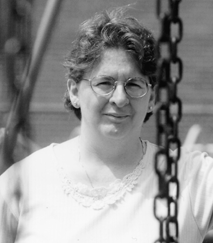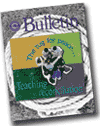 A
culture of peace
A
culture of peace
by Mary Yoder Holsopple, director of the Peace and Justice Collaborative
with Rachel Lapp
When working as a social worker in a local middle school, I met
Carmen and Kim. Both had been suspended for a couple days for fighting,
but it was clear the clash was not finished; they were likely to
come to blows again. I talked with each separately and was not surprised
when they both said the same thing: "I don't know what the
fight was about. But if she wants to fight me, I'll fight. I'm not
a wimp."
Then we all met together. After talking through what led to the
fight, they started laughing - neither of them knew! When we got
to the point of thinking about how to prevent this from happening
again, it suddenly got very complicated for Kim and Carmen. They
readily admitted they could reconcile, however, both also said it
would be difficult for them to tell their friends that all is well
between them. It would have a major impact on their street reputations.
For 10 years, I lived in war zones in Africa. I worked in refugee
camps distributing food and clothing, towels and school kits. I
watched dedicated teachers in barren camps attempt to teach students
to read and write.
I heard stories of the horror of losing family members and homes
during guerrilla raids. I visited hospitals filled with victims
of war.
I assisted children with bloated tummies, starving though surrounded
by fertile soil that could yield abundant food crops if not for
the landmines and guerrilla groups that made it impossible to farm
for survival.
I listened to children tell of becoming soldiers - kidnapped by
guerrilla groups, made to carry looted supplies, taught to maim
and murder, taken back to their villages and even forced to kill
their own family members.
As a person of compassion, I vacillated between righteous anger
and despair. I redoubled my efforts to help the people who were
working to bring the war to an end. I supported negotiators and
mediators with money, training and other assistance as necessary.
Often all I could do was listen. I became convinced that we well-meaning
international helpers must try as hard to prevent war as to assist
innocent victims of war.
When I returned to the U.S. in 1996, I knew I would face reverse
culture shock, but I was not prepared for the amount of violent
images everywhere - television, movie theaters and video games all
had violent content. Magazines and newspapers were filled with more
news of violence in our community and country.
Somehow, I had not anticipated the "meanness" I found
in my own culture. We say things that dehumanize. We are selfish
and greedy (note how frequently we resort to suing each other).
We are competitive to the extreme. What a shock! An even greater
shock came when I made this observation to my friends. Well-educated
people looked at me with quizzical faces asking, "What do you
mean?"
I use the frog analogy: If you put a frog in a pot of boiling water
it will jump out and save itself. If you put that same frog into
a pot of cool water and slowly turn up the heat it will boil to
death without realizing the rise in temperature. Perhaps violence
in our society is like the frog - the temperature is increasing,
but slowly, so we are unaware of what is happening around us.
Working at peace-building requires a commitment and an understanding
of the complexity of our culture and community and working at basic
societal needs as a precursor to rebuilding relationships and reconciliation.
The Peace and Justice Collaborative is in the process of designing
a model for working at local peace building incorporating these
elements. What would happen if every student graduating from Goshen
College, Associated Mennonite Biblical Seminary and Andrews University
had an understanding of this model and experience in local peace
building? No matter what their profession or where they live, alumni
are - and can be - peace builders. PJC also is offering a series
of workshops (see column at right) designed to provide practical
skills for people to improve their own relationships as well as
affect change in how people relate in various settings.
Let me tell you about James. He is one of those kids who often got
in trouble at school because he could not contain his anger. But
like many other kids who appear to be tough, he really is a gentle
soul. I took James to the doctor one day and, while driving home,
he gave me some friendly advice about certain sections of town to
avoid. We talked about where he grew up and how he learned to survive
in his neighborhood in ways that are not in line with behaviors
expected at school. James has difficulty being a chameleon; he knows
how to act on the streets, but he can't change his mindset when
he comes to school.
We often point our fingers at the schools and say, "Do something."
But schools do not operate in a vacuum. Violence is a community
problem: what happens in the community spills over into the school;
what happens at school spills over into the community. The surgeon
general, in a report on youth violence, says that children are safer
at school than at home and in the community, despite highly publicized
incidents of school shootings across the country.
The collaborative will pilot a project at a local middle school
next year, working with select, diverse groups of students to overcome
prejudice, stereotyping, hate crimes and other acts of violence
related to individual or group identity. We will look at these issues
through the lens of media literacy, exploring media both as a positive
tool for social change and negative reinforcer of stereotypes. The
sessions are designed to promote awareness and appreciation of differences,
cooperative learning, perspective taking and empathy building -
inclusion and embracing of the other, regardless of ethnic identity
or social class.
We have to teach children how to get along with one another, particularly
with people with whom they disagree. This builds resiliency in children.
Resilient children are less prone to violence. Creating awareness,
while leaving room to discuss violence itself, can mean pointing
out personal flash points and de-escalation techniques in order
to encourage prevention. Schools also need to have programs to identify
the behaviors of bullies while also examining what makes some kids
targets of bullying, as well as address the role of bystanders.
The most critical risk factor for violence for our children is the
behavior of their peers. A 12-year-old girl once sat in my office
sobbing. "Mrs. Holsopple," she said, "everyone is
telling me I have to give up my gang friends. I can't do that! They
are the only family I have. They are the ones who support and protect
me. They love me and will always accept me no matter what I do."
In her complicated world, she is right - the gang is her family.
It is essential that children feel loved and secure. They need to
experience a sense of belonging, and will find it somewhere. Are
we prepared to rise to the challenge of helping them find it in
socially appropriate ways? If children grow up feeling insecure
about their place in a family and community, and also hear messages
of violence that show them that force is the only way of resolving
problems, how will they grow to be mature adults able to handle
family, workplace and community conflict?
Consider Carmen and Kim. They were able to work out their differences
in a peaceful manner. Over the school year, they even became friends.
I saw them occasionally on the fringes of fights, but not as the
main players. Sometimes that is as much success as one can expect.
James succeeded in completing eighth grade at an alternative middle
school. He is managing to stay "clean" - no small feat,
as a number of extended family members with whom he lives were incarcerated
for theft or drug dealing.
The October issue of the National Education Association's magazine
reported that Deerfield Run Elementary School in Prince George County,
Md., saw student suspension rates drop by 65 percent over the past
year. Why? A program, "Second Step," was introduced to
teach kids empathy, impulse control and anger management. Taught
in all classrooms as part of the regular curriculum, parents were
also invited to a workshop to reinforce those skills at home - a
wonderful example of a school and parents working together to stop
violence before it boils.
We want for our children and our communities a culture of peace.
This is not the work of individuals, but the work of humanity for
its own future.
Mary can be contacted at mholsopple@ambs.edu.
The Surgeon General's report on Youth Violence can be found at www.surgeongeneral.gov/library/youthviolence



 A
culture of peace
A
culture of peace